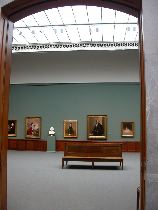 Libby and I ventured over to Pennsylvania Academy of the Fine Arts Friday for the press preview of the museum’s new Hamilton Building and to check out the re-installation of the all-American permanent collection. PAFA, a museum and school established by Charles Wilson Peale, is celebrating its 200th birthday in 2005 and hoping to re-connect with the American populace via a series of exhibits, family workshops, kid friendly activities, symposia, artist’s talks and, my favorite, a re-enactment at Independence Hall on Dec. 26, 2005 of the signing of the PAFA charter by Peale and “70 prominent Philadelphians.” (I love re-enactments and have always wanted to be a re-enactor, but not of butter churning or marching off to battle. This seems like a good event and I’m keeping my calendar open just in case the casting call comes.)
Libby and I ventured over to Pennsylvania Academy of the Fine Arts Friday for the press preview of the museum’s new Hamilton Building and to check out the re-installation of the all-American permanent collection. PAFA, a museum and school established by Charles Wilson Peale, is celebrating its 200th birthday in 2005 and hoping to re-connect with the American populace via a series of exhibits, family workshops, kid friendly activities, symposia, artist’s talks and, my favorite, a re-enactment at Independence Hall on Dec. 26, 2005 of the signing of the PAFA charter by Peale and “70 prominent Philadelphians.” (I love re-enactments and have always wanted to be a re-enactor, but not of butter churning or marching off to battle. This seems like a good event and I’m keeping my calendar open just in case the casting call comes.)
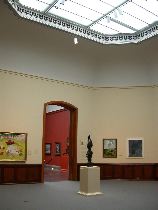
I’ll be writing more about all this for PW (issue of Jan. 19) but here’s a peek at the good old PAFA and some thoughts about the new.
For starters the Furness galleries on the 2nd floor have been buffed up with paint colors that complement the spirit of the Frank Furness-designed Victorian Gothic building. (top images show blue room and yellow room) If you’ve never been, the building — with amazing natural light due to the glass ceilings — is a destination of itself, full of gingerbread details on the outside and sweet touches like gold stars in the ceiling, idiosyncratic lighting designed by the architect and tiles and wainscoting on the inside. Furness predates Frank Lloyd Wright and prefigures that architect’s elegantly decorated structures. (shown below are some of those lights, and the ornate (are they Moroccan-influenced?) arches framing the 2nd floor front galleries.)
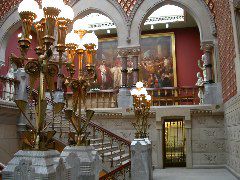
The collection re-installed in Furness is grouped chronologically and makes a nice art and history lesson for the viewer strolling through the spaces. The history lesson stops around 1940 however and must be picked up across the street in the Hamilton Building in several painting and sculpture galleries.
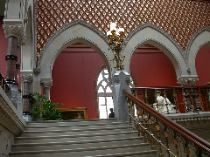
PAFA President Derek Gillman, in his remarks, compared the Academy to the National Gallery in London, saying the collections were roughly the same size but what PAFA lacked — until now — was wall space. Gillman, a Brit who’s been with PAFA since 1999, said one especially nice aspect to the expansion is that they won’t have to take down the permanent collection when they have special exhibits since those exhibits will now be housed in the Hamilton Building. Most obvious case in point — the annual student shows in the Spring which in the past had the run of Furness. Now the student shows will be in Hamilton.)
PAFA’s Kim Sajet, a perky Australian (whose down under accent, coupled with Derek Gillman’s British intonations, made for particularly non-American one two punch during the introductory remarks) was responsible for the permanent collection’s new look. And as she said, more than once, in what sounds like the 2005 marketing theme, “We no longer want to be a hidden treasure. We want to be part of your lives.”

Jeffrey Carr, Dean of the Academy, gave a rousing speech unapologetic in its praise of traditionalism. “We’re traditional but not old fashioned,” he said at one point, pointing to a list of artists whose works are on view in the Hamilton Building’s 2nd floor: Bo Bartlett, Sidney Goodman, Vincent Desiderio, Renee Foulks, Scott Noel, Jan Baltzell, and others. With the exception of Baltzell the list was a hair or two short of exciting. (image is Desiderio‘s “Pantocrater” a new acquisition, installed here in a space with luminous, recessed lighting that looks like it may have been the portal through which that space ship landed at PAFA.)
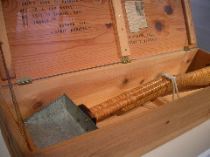
The Academy will continue to teach by its Academy methods (drawing and painting from the model; drawing from the plaster casts, etc.), said Carr. There will be no photography, no video, no graphic design taught. The idea is that students at PAFA will get the tools they need to begin their exploration of the world. What they do later is up to them.
Rogues Gallery
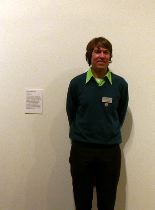
Here I’ll leave off droning and offer a few more photos. Alex Baker, PAFA Curator of Contemporary Art was around showing off a few of the museum’s new acquisitions (a couple Leon Golubs, an H. C. Westerman, (shown above) an Elizabeth Murray).
Baker (right) is an artblog fave known for his affinity for edgy art (he brought Phil Frost and Royal Canadian Arts Lodge to the Morris Gallery and has, both at PAFA and previously at the ICA been very supportive of Philadelphia’s young up and coming artists.) Here Baker posed for me next to the new Murray painting which I cropped out deciding to show Baker instead of the Murray. (You’ll have to imagine it — “Breaking” (1980), a large, split-canvas affair all blues and greens and hard-edged angles notable as being her first split canvas. (And not her best, they got much better later).)
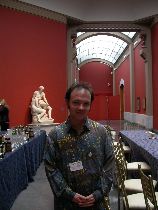
Elsewhere, Assistant Curator Robert Cozzolino, (shown left) a transplant from Madison, WI, (watch out…we’re everywhere) told me about his upcoming works on paper exhibit, “Light, Line and Color” which will show the Academy’s strength in prints and drawings ( 12,000 works in the collection). Cozzolino said he was excited about Philadelphia’s thriving music scene and mentioned the events at Slought in particular.
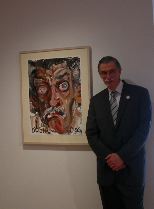
Finally, I ran into Dean Carr when strolling through the Hamilton building. He kindly posed for me next to one of his own works, “Self Portrait,” (right) a striking expressionist work that reminded me of the work of Robert Arneson. Written at the bottom of the piece are the words “Joshu Dog,” which Carr said was a Buddhist koan but was Greek to me.
Libby will have much more to tell you. Stay tuned.









